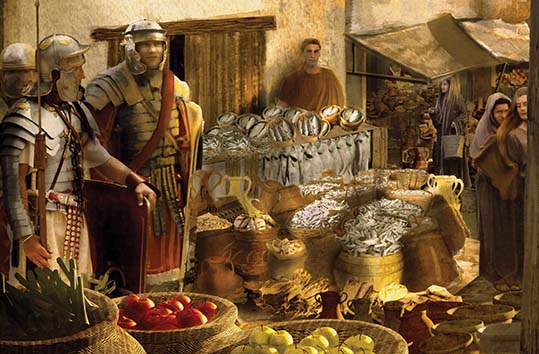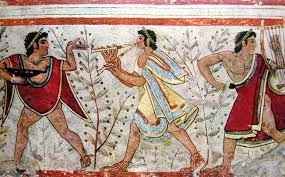Due to the abundant written and archaeological evidence it is quite easy to decode what the typical ancient Roman diet was. Typically split into 3 meals, their cuisine does not often differ from what is on our tables today. Apart from maybe a few surprises.
The Romans weren’t always reclining at a table loaded with roasted ostriches, literally eating until they were sick. The 1,000-year and pan-European extent of Roman history takes in an enormous culinary range. Rome was a hierarchical society too, and the slave ate an enormously different diet from the master he served.

The evidence
The most tangible evidence of the Roman diet is food and human waste excavated by archaeologists. The cities of Herculaneum and Pompeii (destroyed in the 79 AD eruption of Vesuvius) have left sewers and rubbish heaps packed with digested dietary evidence.

Rome’s rich literary and visual culture can also provide clues. Petronius’ over-the-top Satyricon (late 1st century) is probably the inspiration for our imagined decadent banquet. Poets like Horace (65 – 8 BC) and Juvenal (1st – 2nd century) leave clues.
A 10 volume cookbook, Apicius’ De re coquinaria (4th – 5th centuries AD) survives and Pliny the Elder’s great Natural History (c77 AD) is a fine source on edible plants.
When we think of the modern Mediterranean, delicious and vibrant food is one of the first things that come to mind. But how much has the regional food changed over the last two millenia?LISTEN NOWThe daily Roman cuisine
For the ordinary Roman, their diet started with, ientaculum – breakfast, this was served at day break. A small lunch, prandium, was eaten at around 11am. The cena was the main meal of the day. They may have eaten a late supper called vesperna.
Richer citizens in time, freed from the rhythms of manual labour, ate a bigger cena from late afternoon, abandoning the final supper.
The cena could be a grand social affair lasting several hours. It would be eaten in the triclinium, the dining room, at low tables with couches on three sides. The fourth side was always left open to allow servants to serve the dishes.
Diners were seated to reflect their status. The triclinium would be richly decorated, it was a place to show off wealth and status. Some homes had a second smaller dining room for less important meals and family meals were taken in a plainer oikos.

Still life with eggs, birds and bronze dishes, from the House of Julia Felix, Pompeii
Image Credit: Public Domain, via Wikimedia Commons
The Roman diet
The Mediterranean diet is recognised today as one of the healthiest in the world. Much of the Roman diet, at least the privileged Roman diet, would be familiar to a modern Italian.
They ate meat, fish, vegetables, eggs, cheese, grains (also as bread) and legumes.
Meat included animals like dormice (an expensive delicacy), hare, snails and boar. Smaller birds like thrushes were eaten as well as chickens and pheasants. Beef was not popular with the Romans and any farmed meat was a luxury, game was much more common. Meat was usually boiled or fried – ovens were rare.
A type of clam called telline that is still popular in Italy today was a common part of a rich seafood mix that included oysters (often farmed), octopus and most sea fish.
The Romans grew beans, olives, peas, salads, onions, and brassicas (cabbage was considered particularly healthy, good for digestion and curing hangovers) for the table. Dried peas were a mainstay of poorer diets. As the empire expanded new fruits and vegetables were added to the menu. The Romans had no aubergines, peppers, courgettes, green beans, or tomatoes, staples of modern Italian cooking.

A boy holding a platter of fruits and what may be a bucket of crabs, in a kitchen with fish and squid, on the June panel from a mosaic depicting the months (3rd century)
Image Credit: I, Sailko, CC BY-SA 3.0 , via Wikimedia Commons
Fruit was also grown or harvested from wild trees and often preserved for out-of-season eating. Apples, pears, grapes, quince and pomegranate were common. Cherries, oranges, dates, lemons and oranges were exotic imports. Honey was the only sweetener.
Eggs seem to have been available to all classes, but larger goose eggs were a luxury.
Bread was made from spelt, corn (sometimes a state dole for citizens) or emmer. The lack of ovens meant it had to be made professionally, which may explain why the poor took their grains in porridges.
The Romans were cheese-making pioneers, producing both hard and soft cheeses. Soldiers’ rations included cheese and it was important enough for Emperor Diocletian (284 – 305 AD) to pass laws fixing its price. Pliny the Elder wrote on its medicinal properties.
Most of these were the foods of the wealthy. The poor and slaves are generally thought to have relied on a staple porridge. Bones analysed in 2013 revealed poor Romans ate large amounts of millet, now largely an animal feed. Barley or emmer (farro) was also used.
This porridge, or puls, would be livened up with what fruit, vegetables or meats that could be afforded.
Dining out was generally for the lower classes, and recent research in Pompeii has shown they did eat meat from restaurants, including giraffe.
Fish sauce
All classes had access to at least some of Rome’s key ingredients, garum, liquamen and allec, the fermented fish sauces.
The sauces were made from fish guts and small fish, which were salted and left in the sun. The resulting gunk was filtered. Garum was the best quality paste, what passed through the filters was liquamen. The sludge left at the bottom of the sieve was a third variety, allec, destined for the plates of slaves and the really poor.
Herbs would be added to local or even family recipes.
These highly nutritious sauces were used widely and garum production was a big business – Pompeii was a garum town. Soldiers drank it in solution. The poor poured it into their porridge. The rich used it in almost every recipe – it might be compared to Worcestershire sauce or soy sauce or far-eastern fish sauces today – from the savoury to the sweet.








